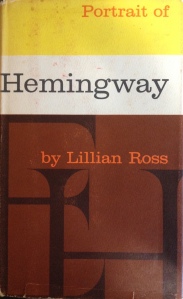 Lillian Ross originally wrote her ‘Profile’ of Ernest Hemingway for The New Yorker, where it was published on May 13, 1950. In book form, it becomes a ‘Portrait,’ and other than the addition of a delightful preface, I’m not sure what the difference is; the opening pages of my first edition note that Portrait originated as Profile, but there is no indication that the text of both is not the same.
Lillian Ross originally wrote her ‘Profile’ of Ernest Hemingway for The New Yorker, where it was published on May 13, 1950. In book form, it becomes a ‘Portrait,’ and other than the addition of a delightful preface, I’m not sure what the difference is; the opening pages of my first edition note that Portrait originated as Profile, but there is no indication that the text of both is not the same.
The dust cover offers context.
When Miss Ross wrote this Profile, she made several literary innovations, one of which was to compose a portrait entirely in terms of action… She attempted to put down only what she had seen and heard, and not to comment on the facts or express any opinions or pass any judgments… In her writing for The New Yorker she has raised this severely objective method to an art.
We’ll examine that premise shortly.
The Portrait runs 42 pages: long for a magazine article, but perfectly lovely as a brief glimpse in this format. Let me start where the book does, though. I date the preface to 1961: that is the publication date of this first edition printing; the preface does refer to the reception to her Profile in the magazine, and it refers to Hemingway’s death of July 2 of that year. In it, Ross explains how she got to know Ernest Hemingway and his fourth and final wife, Mary, how they corresponded with each other as friends, and how the profile came about: on a brief stay in New York City on his way to Italy, Hemingway invited Ross to come and hang around with him on various errands, over the course of three days. She wrote up those experiences, and gave Mr. and Mrs. H. the chance to mark up her manuscript before she submitted it. She then describes the responses to her profile. Most readers loved it, she said, but some “reacted violently, and in a very complicated fashion.” Some of these disliked Hemingway’s personality (not an uncommon reaction to the man) and thought the piece backed up their views. Others didn’t like the man as represented in the piece (also understandable), and thought “either Hemingway had not been portrayed as he was or, if he was that way, [Ross] shouldn’t have written about him at all.” She assumes that Hemingway’s death has corrected some of these disapproving interpretations, which I found a little odd, but no matter. Finally, she continues the work of profiling Hem by describing the kind of letter-writer and friend he was. The preface introduces the profile nicely because it gives context to the relationship between writer and character.
And the profile (portrait) itself is indeed wonderful, and as promised, follows Hemingway closely: from arriving at the airport, to the airport bar, to the hotel, where the Hemingways order up caviar, champagne and Marlene Dietrich, who visits with photos and stories of her grandbaby. Then it is late in the next morning, and Ross is awakened by an antsy Hemingway who demands she come over and listen to him talk; more champagne, and she accompanies him on his errands while Mary goes on hers. They buy Papa a coat and other small items at Abercrombie & Fitch. The next morning again, Patrick (the middle Hemingway son) has joined the party, which goes to the Met to “look at pictures” for a few hours, followed by lunch back at the hotel with Charles Scribner (Hemingway’s longtime editor). The story ends mid-lunch.
Ross relates this series of anecdotes as scenes, blow by blow, in real time. It is true, as promised, that this is a portrait “in terms of action,” but I wouldn’t call it “severely objective.” For starters, there is the question of what you put in and what you leave out – because obviously Ross didn’t report every cough and sigh and rustle of a pant leg that took place in three days. She writes, “Patrick told me that he’d just as soon spend the whole day looking at pictures.” And a couple of pages later, Hem gets tired and asks Patrick, “don’t you think two hours is a long time looking at pictures?” and “everybody agreed” and the party moved on. Choosing to put in these contradicting statements says a lot about both Hem and Patrick, and I don’t believe for a moment that that was a mistake.
Too, word choice is always telling, I think. In the nature of this excellent piece my mother sent me the other day, consider the sentence: “He moved in and took the room.” Who can objectively say that Hemingway took the room? No, Lillian Ross is communicating something outside of objectively observable events here. I’m not saying I don’t like it: I do, in fact, very much. But I don’t think it’s entirely accurate to claim that the author is not present in her work – here, or ever.
That’s just a quibble with the dust jacket, though. This vignette is packed with great representative moments. I’ve already shared a few (here, here). Or how about this for a Hemingway speech:
…I was ashamed because I had not written any novels. So I wrote ‘The Sun’ when I was twenty-seven, and I wrote it in six weeks, starting on my birthday, July 21st, in Valencia, and finishing it September 6th, in Paris. But it was really lousy and the rewriting took nearly five months. Maybe that will encourage young writers so they won’t have to go get advice from their psycholoanalysts. Analyst once wrote me, What did I learn from psychoanalysts? I answered, Very little but hope they had learned as much as they were able to understand from my published works. You never saw a counter-puncher who was punchy. Never lead against a hitter unless you can outhit him. Crowd a boxer, and take everything he has, to get inside. Duck a swing. Block a hook. And counter a jab with everything you own. Papa’s delivery of hard-learned facts of life.
Seriously, he’s sort of simultaneously a genius and a walking cariacature. I understand perfectly why those readers thought Ross was making fun of Hemingway; this kind of speech reads that way. I also believe he spoke it. And I like him even while recognizing that he was a blowhard, could be a jerk, and struggled to contain his overcompensating machismo. But I get why others don’t. This is sort of in line with that post I wrote.
I had a wonderfully fun time reading the essence of Hemingway in this perfectly pitched profile. Very enjoyable, and a quirky piece of journalism. Do look it up.
Filed under: book reviews | Tagged: authors, Hemingway, journalism, nonfiction |







… and, interestingly human, you write especially well when you are having a fun time reading; I liked your quibbling with the dust jacket.
Thank you! You’ve said this before. I wonder how clear it is to those who are following a little less closely. One more reason to only read REALLY GOOD books.